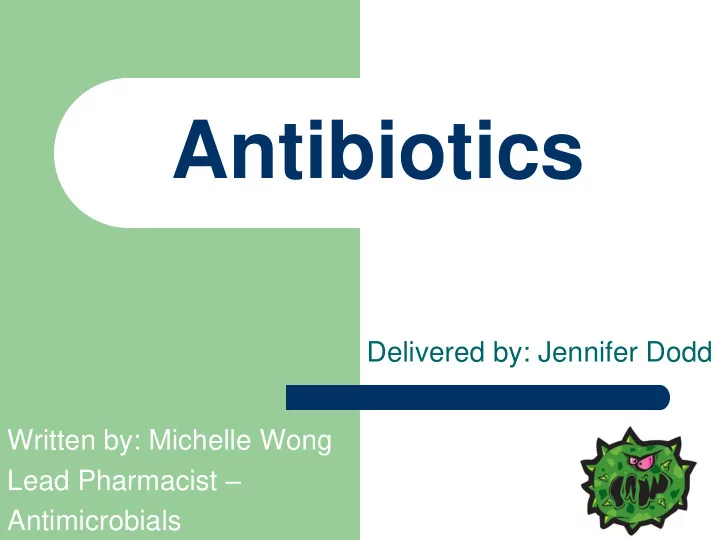

Antibiotics Delivered by: Jennifer Dodd Written by: Michelle Wong Lead Pharmacist – Antimicrobials
In the next 30 minutes How to access the Antimicrobial Formulary What is expected for every antibiotic prescription MCQs Audit
What antibiotic information is available? Antimicrobial Formulary for adults (plus summary) and paediatrics available on the Intranet Vancomycin and gentamicin dosing guidelines Surgical prophylaxis guidelines Contact consultant microbiologists for antibiotic advice Ward pharmacists BNF
Antimicrobial Formularies Antimicrobial Formularies
Tips…. Contents page – Hyperlinks to empiric treatment for each type of infection Lists ‘High risk C difficile antibiotics’, and risk factors C Diff treatment - also CDI policy Principles of good antimicrobial prescribing Restricted antimicrobial list: Red, Amber
Change from IV to oral guide Microbiological specimens Management of MRSA Dosing in Renal Impairment Vancomycin/gentamicin guideline Antimicrobial prophylaxis post-splenectomy
Antibiotic Prescribing Tips Allergy box completed Antibiotic, route, dose and frequency Review date at 48 hours/72 hours Stop date (5 days if empiric) Use the shortest duration of treatment suitable for the infection Indication recorded on prescription chart, as well as medical notes IV antimicrobials review after 48 hours – to oral? Printed Name and bleep number
Is this OK?
Good example
Therapeutic Drug Monitoring
Vancomycin Monitoring
Gentamicin monitoring 80 year old male, 80kg (not obese) Urosepsis Creatinine 112micromole/L (CrCl 53ml/min) Gentamicin level at 9:00am 2/1/12 = 3.1mg/l What do you do?
Gentamicin monitoring Taken too early - insignificant Should be taken 1-4 hours before the 2 nd dose Repeat level at ~6-9pm Nursing to document time of administration and time of sample in the medical notes
GDH + & C. Difficile + Patients GDH – Glutamate Dehydrogenase GDH – ve GDH +ve + C. Diff toxin – ve GDH +ve and C. Diff toxin +ve
Key top interactions… Antifungals/quinolones/rifamycins – LOTS of interactions! Most antimicrobials – Warfarin Macrolides/Daptomycin/Fusidic Acid – Statins Daptomycin – Measure CK Trimethoprim – Methotrexate Aminoglycosides – IV diuretics
Question 1 Which ONE of the following is the most likely pathogen in Community acquired pneumonia? Streptococcus pneumoniae a) Pseudomonas aeruginosa b) Moraxella catarrhalis c) E.coli d) Streptococcus pyogenes e)
Question 2 Which ONE of the following is the most likely pathogen in exacerbation of COPD? Streptococcus pneumoniae a) Staphylococcus aureus b) Haemophilus influenzae c) Anaerobes d)
Question 3a A 78 year old lady is admitted to hospital with SOB, and coughing up green sputum. CXR showed right basal consolidation. Ur: 8.8, BP: 80/40, AMT: 10, RR: 23. What is the severity of this patient’s pneumonia? Mild a) Moderate b) Severe c)
Question 3b For the same patient, what antimicrobial treatment would you commence them on? (Patient has no known drug allergies) IV Co-amoxiclav + IV Clarithromycin a) Oral Amoxicillin alone b) Oral Amoxicillin + Oral Clarithromycin c)
Question 3c For the same patient, which of the following Microbiological specimens should you take? Pneumococcal urinary antigen a. Legionella urinary antigen – after speaking b. to microbiologist Blood culture c. Sputum sample d. All of the above e.
Question 3d The first results that come back for the patient are Pneumococcal Ag +ve, Legionella Ag-ve, what changes could you make to the patient’s treatment, if any? Continue with same regimen a) Stop IV Clarithromycin b) Switch IV Co-amoxiclav to oral Amoxil c) IV to oral switch for both Co-amoxiclav and d) Clarithromycin
Question 4 A patient is admitted with non-severe cellulitis and has a MRSA screen, the screen is positive. What antibiotic treatment would be appropriate? Doxycycline a) Flucloxacillin b) Clarithromycin c) Cefalexin d)
Question 5 Which of the following antibiotics are high- risk for precipitating C. difficile infection? Co-amoxiclav a) Ciprofloxacin b) Ceftriaxone c) All of the above d)
Question 6 Which ONE of the following is a risk factor for Clostridium difficile infection? Morphine sulphate a) Loperamide b) Omeprazole c) Paracetamol d) Dalteparin e)
Question 7 A patient is receiving IV Vancomycin 1g OD for a MRSA wound infection, your SHO asks you to switch to oral treatment. Which of the following is the most suitable action? Sodium fusidate 500mg po tds a) Rifampicin 600mg po bd + Doxycycline 100mg po bd b) Vancomycin 250mg po qds c) Flucloxacillin 500mg po qds d) Contact microbiologist e)
Question 8 A patient is receiving Vancomycin 1g IV bd, a pre-dose level is taken before the 4 th dose, the level is 25.0mg/L, what action would you take? Continue with current regimen a) Stop IV Vancomycin b) Reduce dose to 1g OD c) Increase dose to 1.5g BD d)
Question 9 Your SHO asks you to prescribe gentamicin for a 50year male patient with suspected urosepsis? Seen on A+E. What information do you need? Weight 1. Renal function 2. Previous A+E documention 3. All of above 4.
Question 10 Your patient has been diagnosed with severe Hospital Acquired Pneumonia. Has been started on co-amoxiclav IV 1.2g TDS. History of CDT. What do you do? Speak to microbiologist regarding management a) Add in metronidazole b) Continue with co-amoxiclav c) All of above d)
Audit Data on compliance with the antibiotic formulary done quarterly. If interested in participating in an audit contact antimicrobial pharmacist/microbiologist
WHO definition - HAI Patient admitted for reason other than Infection Infection was not present or incubating at admission Develops over 48 hours after admission Develops post discharge Also includes occupational infections in HCW
Screening MRSA (Limited) CPC (All those admitted to other hospital in last 12m) VRE (Known positives and those admitted from units with high prevalence
Total Opportunites, Hand Hygiene Events, and Percent 700 600 500 400 Opportunities Hygiene Percent 300 200 100 0 Staff nurse Consultant Junior doctor Allied Sister Student nurse Senior doctor HCA Porter
HAND HYGIENE We do not wash our hands as often we think we do Single most important thing you can do to prevent the spread of infection. Hand hygiene SAVES LIVES. Single most effective intervention during XDR bacterial outbreaks.
Good luck Any questions???
Recommend
More recommend